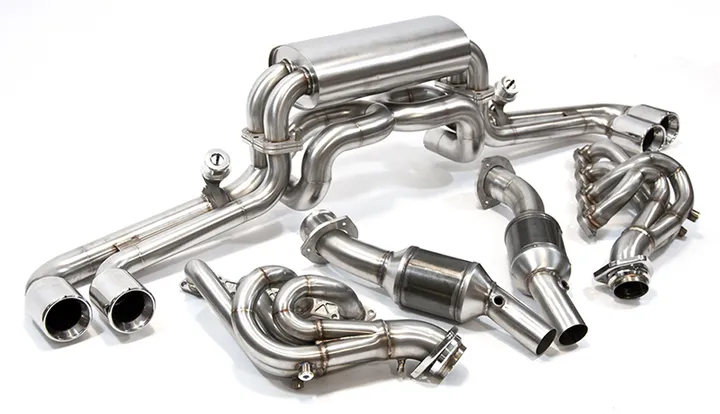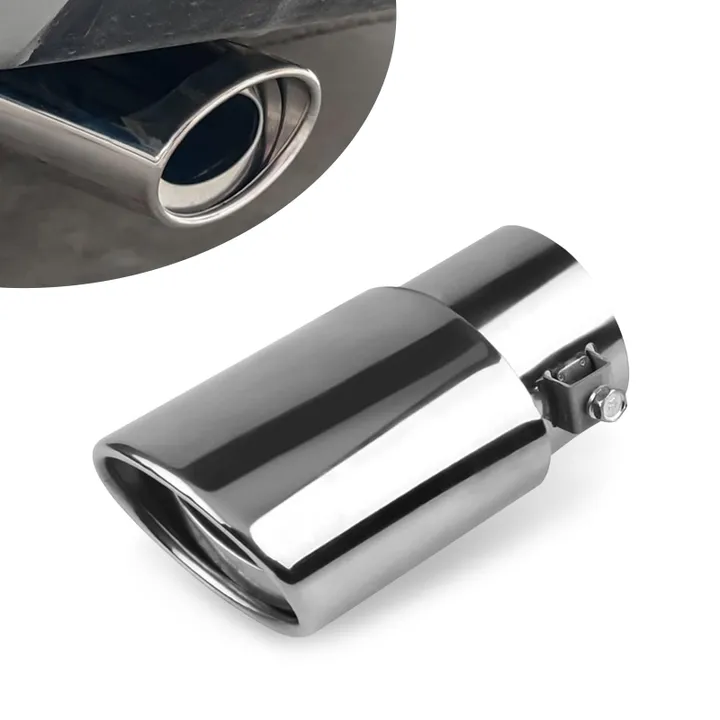


An exhaust system plays a critical role in a vehicle's performance, emissions control, and overall efficiency. While traditional exhaust systems are made from mild steel or aluminized steel, stainless steel has emerged as a superior material choice due to its exceptional durability, corrosion resistance, and ability to enhance performance. This comprehensive guide delves into the world of stainless steel car exhaust systems, exploring their benefits, types, manufacturing processes, installation considerations, and maintenance requirements.

Stainless steel exhaust systems offer a range of advantages over their conventional counterparts, making them an attractive choice for vehicle owners seeking longevity, improved performance, and enhanced aesthetics. These systems are designed to withstand harsh environmental conditions, resist corrosion, and optimize exhaust flow, resulting in increased horsepower and better fuel efficiency.
Here are some key benefits of stainless steel exhaust systems:
| Benefit | Description |
|---|---|
| Corrosion Resistance | Stainless steel is highly resistant to rust and corrosion, ensuring a longer lifespan for the exhaust system, particularly in regions with harsh weather conditions or exposure to road salt. |
| Improved Performance | These systems are engineered to reduce backpressure and improve exhaust flow, leading to better engine performance, increased horsepower, and improved fuel efficiency. |
| Aesthetic Appeal | Stainless steel exhaust components can be polished or brushed to achieve a sleek, high-end appearance, enhancing the overall aesthetics of the vehicle. |
| Low Maintenance | Stainless steel exhaust systems require minimal maintenance compared to mild steel exhausts, saving time and money in the long run. |
The two most commonly used grades of stainless steel in exhaust systems are 304 and 409. Here's a comparison of these two grades:
| Grade | Type | Composition | Characteristics | Applications |
|---|---|---|---|---|
| 304 | Austenitic | High levels of chromium (18-20%) and nickel (8-10.5%) | Highly corrosion-resistant and durable, golden hue when exposed to high temperatures | High-end exhaust systems |
| 409 | Ferritic | Lower chromium (10.5-11.7%) and no nickel | Excellent corrosion resistance and heat tolerance, more affordable than 304 | Aftermarket and OEM exhaust systems |
Other grades, such as 321 and 316L, are also used in specialized applications or extreme environments.
The manufacturing process of stainless steel exhaust systems involves several intricate steps to ensure precise fitment, optimal performance, and a high-quality finish.
The process begins with stainless steel sheets being rolled and welded to create exhaust pipes and tubing. These tubes are then bent into the desired shapes using specialized machinery to ensure precise fitment for each vehicle model. Accurate bending is crucial to prevent exhaust leaks and maintain proper exhaust flow.
Once the tubing is formed and bent, components such as mufflers, catalytic converters, and flanges are welded to the tubing, creating a complete exhaust system. Skilled welders ensure strong, leak-proof connections between the various components, ensuring the system's integrity and longevity.
The welding process involves the following steps:
Preparation: The components are cleaned and prepared for welding.
Tack welding: Temporary welds are made to hold the components in place.
Welding: The components are permanently welded together using specialized welding techniques.
Inspection: The welded joints are inspected for quality and integrity.
The final step in the manufacturing process is polishing and finishing. Exhaust components can be polished or brushed to achieve the desired aesthetic finish, ranging from a sleek, mirror-like appearance to a brushed, satin look. This step not only enhances the visual appeal of the exhaust system but also helps protect the stainless steel from environmental factors.
Polishing and finishing techniques may include:
Mechanical polishing: Using abrasive materials to remove surface imperfections and create a smooth, reflective finish.
Electropolishing: An electrochemical process that removes a thin layer of material, resulting in a highly polished surface.
Brushed finish: A textured finish created by brushing the surface with abrasive materials, resulting in a satin-like appearance.
Proper installation and maintenance are crucial for ensuring the optimal performance and longevity of a stainless steel exhaust system.
It is highly recommended to have a stainless steel exhaust system installed by a professional mechanic or exhaust specialist. These professionals have the expertise and specialized tools to ensure correct fitment, alignment, and proper sealing of the system. Improper installation can lead to exhaust leaks, reduced performance, and potential safety hazards.
Here are some key considerations for professional installation:
Proper alignment and fitment of the exhaust components
Secure mounting and hanging of the exhaust system
Proper sealing of joints and connections
Compliance with local regulations and emissions standards
Specialized tools and equipment for installation
Stainless steel exhaust systems require minimal maintenance compared to their mild steel counterparts. However, regular inspections and cleaning can help maintain the system's appearance and prevent any buildup of debris or contaminants. Proper cleaning techniques, such as using specialized stainless steel cleaners and avoiding abrasive materials, can help preserve the system's finish and prevent premature corrosion.
Maintenance and cleaning tasks may include:
Visual inspections for signs of damage, leaks, or corrosion
Removal of debris and contaminants from the exhaust system
Cleaning with appropriate stainless steel cleaners and polishes
Lubrication of hangers and mounting points
Replacement of damaged or worn components

While stainless steel exhaust systems are generally more expensive than their mild steel counterparts, the investment is often justified by their extended lifespan and performance benefits.
The cost of a stainless steel exhaust system can vary depending on the brand, grade of stainless steel, and the specific components included. On average, these systems can cost anywhere from 20% to 50% more than a mild steel exhaust system. However, the initial investment can be offset by the system's longevity and reduced maintenance costs over time.
Here's a comparison of the average costs for different exhaust system materials:
| Material | Average Cost |
|---|---|
| Mild Steel | $200 - $500 |
| Aluminized Steel | $300 - $700 |
| Stainless Steel (304 grade) | $400 - $1,000 |
| Stainless Steel (409 grade) | $300 - $800 |
Reputable manufacturers of stainless steel exhaust systems typically offer warranties ranging from 3 to 5 years or longer, depending on the specific product and brand. These warranties provide assurance and protection for the investment, covering defects in materials and workmanship.
Common warranty coverage may include:
Defects in materials and workmanship
Corrosion or rust-through protection
Replacement or repair of defective components
Labor costs for warranty repairs
It's important to review the specific warranty terms and conditions provided by the manufacturer to understand the coverage and any limitations or exclusions.
When selecting a stainless steel exhaust system, it is essential to consider factors such as your vehicle type, performance needs, and budget.
Different vehicles have varying exhaust system requirements based on their engine size, performance characteristics, and intended use. High-performance vehicles or those used in off-road or extreme environments may require exhaust systems made from higher-grade stainless steel or specialized materials like titanium or Inconel for optimal performance and durability.
Here are some common vehicle types and their exhaust system considerations:
| Vehicle Type | Exhaust System Considerations |
|---|---|
| Passenger Cars | Mild steel or aluminized steel systems may suffice for daily driving conditions. Stainless steel systems offer improved performance and longevity. |
| Sports Cars | High-performance stainless steel systems are recommended to handle increased exhaust flow and temperatures. |
| Trucks and SUVs | Stainless steel systems with larger components are necessary to accommodate larger engines and towing capabilities. |
| Off-Road Vehicles | Durable stainless steel or specialized materials are required to withstand extreme conditions and terrain. |
Reputable brands like Borla, Magnaflow, and Walker offer a wide range of stainless steel exhaust system options for various vehicle makes and models. These brands are known for their quality, performance, and reliability, ensuring that you get a product that meets your expectations.
When selecting a brand, consider the following factors:
Reputation and customer reviews
Quality of materials and manufacturing processes
Availability of fitment options for your vehicle
Warranty coverage and customer support
While stainless steel exhaust systems are more expensive than their mild steel counterparts, it is important to consider your budget and prioritize your needs. Entry-level systems may be more affordable but may not offer the same level of performance or durability as higher-end options. Striking a balance between cost and desired features is crucial when making your selection.
Here are some budget considerations:
Determine your priorities: performance, longevity, or aesthetics
Compare prices from different brands and retailers
Consider the long-term cost savings of a durable stainless steel system
Explore financing options or payment plans if available
Upgrading to a stainless steel exhaust system is an investment that can significantly enhance your vehicle's performance, durability, and aesthetic appeal. With its corrosion resistance, improved exhaust flow, and low maintenance requirements, a stainless steel exhaust system can provide long-lasting benefits and peace of mind. Whether you're a performance enthusiast or simply seeking a reliable and durable exhaust solution, stainless steel is an excellent choice for your vehicle. By considering factors such as vehicle type, performance needs, and budget, you can select the perfect stainless steel exhaust system to meet your specific requirements.
An exhaust system plays a critical role in removing harmful gases from the engine and improving overall vehicle performance and efficiency. It helps reduce emissions, increase fuel economy, and optimize engine power output.
The most common materials used for exhaust systems are mild steel, aluminized steel, stainless steel (grades 304 and 409), and in some high-performance applications, titanium or Inconel alloys.
Stainless steel is preferred because it offers superior corrosion resistance, durability, and heat resistance compared to mild steel, ensuring a longer lifespan for the exhaust system.
304 grade is an austenitic stainless steel with higher chromium and nickel content, providing better corrosion resistance and weldability, while 409 grade is a ferritic stainless steel with lower chromium and nickel content, making it more affordable but less corrosion-resistant.
304 grade stainless steel is considered better because its higher chromium and nickel content offers superior corrosion resistance, strength, and heat resistance, ensuring a longer lifespan and better performance for the exhaust system.
The material of the exhaust system can impact vehicle performance by affecting exhaust flow, backpressure, and heat dissipation, which in turn can influence engine power output, fuel efficiency, and overall drivability.
Titanium and Inconel alloys offer exceptional strength, heat resistance, and lightweight properties, making them suitable for high-performance exhaust systems in exotic or race cars, although they are significantly more expensive than stainless steel.
The manufacturing processes, such as forming, welding, and finishing, can vary depending on the material used, with stainless steel and titanium requiring specialized techniques and equipment compared to mild steel or aluminized steel.
When choosing an exhaust system material, factors to consider include the intended use (daily driving or high-performance), desired lifespan, budget, and environmental conditions (e.g., exposure to road salt or coastal areas).
Proper maintenance, such as regular inspections, cleaning, and repairs, can significantly extend the lifespan of an exhaust system by preventing corrosion, damage, and premature failure, regardless of the material used.

Sarah isn't your average gearhead. With a double major in Mechanical Engineering and Automotive Technology, she dived straight into the world of car repair. After 15 years of turning wrenches at dealerships and independent shops, Sarah joined MICDOT to share her expertise and passion for making cars run like new. Her in-depth knowledge and knack for explaining complex issues in simple terms make her a valuable asset to our team.








